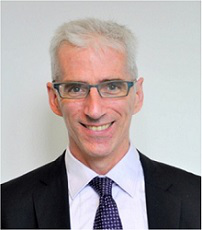
Speaker: Joel W. Ager
Place: Yuanwang Lu, 7th floor, Building Chao Kuang Piu, School of Materials Science & Engineering
Title: Elementary Steps in the Electrochemical Conversion of CO2 to C-C Coupled Products
Time: 18th January, 2019, 10:00 a.m.
Inviter: Haobin Wu
Abstract:
Electrochemical conversion of CO2 (EC-CO2R) to chemical precursors and/or fuels is of fundamental and technological interest. If driven by renewable power sources such as wind and/or solar, widespread adoption of such a technology could slow the rate of carbon dioxide emissions into the atmosphere by replacing chemicals obtained from oil with sustainably generated alternatives. Indeed, we have shown recently that that C-C coupled products such as ethylene and ethanol can be produced with solar light using Cu-based electrocatalysts at an overall efficiency of over 5%, which is ca. 10x the efficiency of natural photosynthesis [1].
However, challenges remain in terms of controlling the selectivity of the process. Indeed, the multi-electron reduction of CO2 to products such as ethanol (12 e-), ethylene (12 e-), and propanol (18 e-) represents the most ambitious synthetic chemistry to be performed with electrocatalysis [2]. Formation of these products involves a corresponding number of surface bound intermediates linked by proton-coupled electrons transfers, chemical steps, and interactions with the solvents [3]. Identification of the elementary steps in these complex chemical conversion processes is obviously crucial for developing more selective catalysts.
Recent experimental work aimed at identifying selectivity-determining steps in multi-electron CO2 reduction will be presented. In a process that was never previously predicted or observed, C16O reduction in H218O electrolyte produces oxygenate products (ethanol, acetate, propanol) containing 18O which must have originated from the solvent. As a result of this discovery, previously proposed mechanisms for CO and CO2 reduction on Cu under aqueous conditions require reexamination. In the case of ethanol, a new chemical step involving concerted hydrolysis of *CCH mediated by a Grotthuss chain of 6 water molecules was identified [3]. Tandem cascade electrocatalysis has been realized using CO at the intermediate species on micropatterned Ag/Au and Cu. This approach allows tuning of the CO activity at the surface of Cu during CO2R; increasing CO activity boosts oxygenate production at the expense of ethylene [4]. Finally, electrochemical reduction of isotopically labeled CO/CO2 mixtures is used to identify product-specific active sites for ethylene, ethanol and acetate, and 1-propanol. The existence of such sites implies that it should be possible to create Cu-based electrocatalysts which will be much more selective than what is available today [6].
(1) Gurudayal; Bullock, J.; Srankó, D. F.; Towle, C. M.; Lum, Y.; Hettick, M.; Scott, M. C.; Javey, A.; Ager, J. Energy Environ. Sci. 2017, 10, 2222�2230.
(2) Hori, Y., in Modern Aspects of Electrochemistry; Springer New York. 2008; pp 89�189.
(3) Kortlever, R.; Shen, J.; Schouten, K. J. P.; Calle-Vallejo, F.; Koper, M. T. M. J. Phys. Chem. Lett. 2015, 6, 4073�4082.
(4) Lum, Y.; Cheng, T.; Goddard, W. A.; Ager, J. W. J. Am. Chem. Soc. 2018, 140, 9337�9340.
(5) Lum, Y.; Ager, J. W. Energy Environ. Sci. 2018, 11, 2935-2944.
(6) Lum, Y.; Ager, J. W. Nature Catal. 2018, DOI:10.1038/s41929-018-0201-7.
Biography:
Xiaoqing Pan is the Henry Samueli Endowed Chair in Engineering, and Professor of Chemical Engineering & Materials Science, Professor of Physics & Astronomy at the University of California-Irvine (UCI). He is also the inaugural Director of the Irvine Materials Research Institute (IMRI) at UCI.Pan's research interests center on the development of atomic resolution transmission electron microscopy (TEM) and in situ techniques, leading understanding of the atomic-scale structure-property relationships of advanced functional materials. He has published over 400 peer-reviewed scientific papers in scholarly high impact factor journals. His work has been cited over 20,000 times and his h-factor is 76 (Google Scholar). He has given more than 250 plenary, keynote or invited presentations at national and international conferences, and more than 200 invited seminars in national and international institutions.
Dr. Joel W. Ager III is a Staff Scientist in the Materials Sciences Division of Lawrence Berkeley National Laboratory and an Adjunct Full Professor in the Materials Science and Engineering Department, UC Berkeley. He is a Principal Investigator in the Electronic Materials Program and in the Joint Center for Artificial Photosynthesis (JCAP) at LBNL and in the Berkeley Educational Alliance for Research in Singapore (BEARS) where he serves as Co-Lead PI of the eCO2EP project with Cambridge University Professor Ager is a frequent invited speaker at international conferences and has published over 300 papers in refereed journals. His work is highly cited, with over 28,000 citations and an h-index of 85 (Google Scholar).



